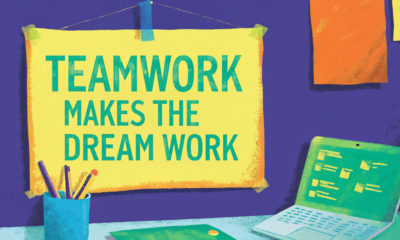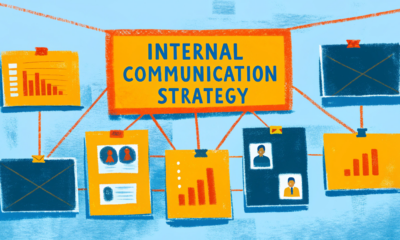Performance
Building a Sustainable High-Performance Culture (Without Burning Out Your Team)

You walk into the office. Everyone’s smiling and full of energy. Projects are ahead of schedule. Clients keep coming back for more. Around the coffee machine, there’s excited chatter about fresh creative ideas. Partners are lining up to collaborate. Leadership is handing out bonuses and promotions left and right…
It’s basically a workplace utopia. Add a few pink clouds and unicorns galloping over rainbows, and you’ve got yourself a fever dream of corporate bliss.
But let’s be honest — when was the last time your Monday looked like that?
Sure, it sounds like the ideal high-performance culture — but most leaders know it’s rarely that simple. In real life, high performance can feel more like a pressure cooker than a playground. The expectation to always deliver leaves people drained, stretched thin, and eventually running on autopilot.
Sometimes, it seems like high-performance culture was built to wring out every last drop of energy, and leave behind a pile of ashes where someone’s spark used to be. You start with passion and end with presenteeism: people showing up, but completely checked out.
But what if that dream — at least parts of it — could be real? Okay, maybe not the unicorns. But the energy, the clarity, the sense of momentum and purpose — that doesn’t have to be a fantasy.
High-performance culture is everywhere now. You see it in LinkedIn posts, corporate mission decks, offsite agendas. It’s sold as the gold standard — the target every team should aim for. And in a world demanding faster, better, more — it’s easy to fall into the trap of expecting superhuman results from very human teams.
And the world around us? It’s not slowing down.
Faster decisions. Bigger goals. More stretch with fewer resources. Leaders expect outcomes. Employees want boundaries. The rules have changed, and if culture can’t evolve, performance won’t hold.
So…
Is it possible to build a culture where the bar stays high — but the people don’t burn out trying to reach it?
A place where motivation, results, and team energy can actually coexist?
Let’s find out.
What is high-performance culture, really?
Q: What is a high-performance culture in the workplace?
A: A high-performance culture is an organizational environment where individuals and teams consistently achieve ambitious goals through shared values, accountability, collaboration, and continuous improvement. It prioritizes both results and behavior, creating systems that align people with performance expectations.
That’s the formal definition. The one that looks great in strategy decks and HR handbooks.
But in real life, high-performance culture feels different. It’s a steady hum of momentum — a team that delivers without being chased. It’s the quiet pride of pushing limits and knowing your work matters. It’s energy, drive, and clarity. And when it works, it feels powerful.
When it doesn’t, it starts to unravel:
- You’ll see late-night emails, not because they’re urgent, but because no one feels safe slowing down.
- You’ll notice top performers showing up, yet emotionally checked out.
- You’ll sense the mood shift — from driven to drained — even if deadlines are still being met.
Sometimes, performance becomes survival. Not purpose. High-performance culture has long been treated as a business ideal. Something to strive for. A badge of excellence. But the world has changed. And that gold standard? It’s no longer built to last.
Why the old model doesn’t work anymore
Today’s workplace is more like a buzzing hive than a traditional team. Different generations, values, and expectations collide in every Zoom call and strategy meeting. Gen X stability meets Millennial recovery. Baby Boomer legacy meets Gen Z clarity. It’s fast, fragmented, and full of noise.
Younger professionals bring with them a different kind of energy — and a very different set of rules.
They don’t chase praise for burnout. They’ve seen what happens when boundaries vanish. Many have already felt the consequences of working past their limit too early in life. Now they guard their energy. They log off when the day ends. They ask why before they commit. And they stay only where their voice matters.
Their definition of performance is more balanced:
- It’s about impact, not hours.
- It’s about focus, not constant hustle.
- It’s about doing great work — and having the space to recover after.
The old hustle-hard formula simply doesn’t compute anymore. It burned too hot, too long, and left entire teams depleted. The idea that success must come at the cost of self has finally run out of steam.
And the signals are everywhere:
- Quiet quitting is a normalized phrase.
- AI tools, while helpful, often stretch humans further instead of lifting the weight.
- Engagement data shows growing gaps between effort and emotional investment.
The new rule is simple but hard: Performance still matters, but never at the expense of people.
Support your team first. Make space for them to breathe, reflect, and recharge — not just perform. Because when high performers burn out, they don’t always wave their hands in the air.
They don’t scream for help. They go quiet. They start to sink.
Just like someone slipping underwater, it happens gradually, and often silently. Deadlines still get met. Emails still go out. But something essential fades, and by the time it’s visible, the damage is already done.
Burnout rarely looks dramatic. It looks like presenteeism. Like disengagement dressed up as professionalism.
And the real cost? You lose your best people without even realizing it — until they’re gone.
The bright and dark sides of high performance
So what does high performance actually feel like on the ground? It depends. Sometimes, it looks like momentum, clarity, and collective energy. Other times, it hides quiet exhaustion behind glowing metrics. That’s the paradox.
High-performance culture has two faces — and it’s crucial to recognize both if you want to lead with intention.
The bright side
When it works, it works beautifully. A well-tuned high-performance culture doesn’t just hit goals — it creates a rhythm where doing great work feels natural.
- Teams operate in flow, with shared ownership and real clarity.
- Employees grow — not just in output, but in skill, voice, and confidence.
- Purpose isn’t some framed statement on the wall. It’s in the way people show up every day.
- Results don’t require pushing. They emerge from alignment and trust.
When the culture clicks, success feels less like pressure and more like possibility. You see innovation, resilience, and a kind of grounded pride.
But only if the balance holds.
The shadow side
The same drive that fuels success can also become its downfall.
- Chronic overwork gets mistaken for dedication.
- Recognition goes to whoever delivers most — not necessarily who leads with integrity or lifts others.
- Time off becomes a silent liability. Rest is seen as weakness.
- Trust fades, even if the numbers still look good.
High performance, in its toxic form, becomes a mask. From the outside, everything looks impressive — ambitious goals, record-setting quarters, engaged meetings. But underneath, the energy is brittle. And the collapse usually starts quietly.
Ask yourself:
- Are your highest performers also your most tired?
- Do results hold steady when leadership steps away — or do they crumble?
- Is feedback honest, or just polite silence?
- Can your team perform without pressure — or does performance depend entirely on being pushed?
Because if performance only exists under pressure, it’s not a culture — it’s a countdown.
Mindset: the beliefs that shape the culture
Every culture begins with mindset — not with mission statements on the wall or corporate slogans. It’s born in what leaders truly think and what they pay attention to. Not in what is said, but in what is rewarded, allowed, and repeated over and over again.
In fact, according to Culture Amp’s 2025 report, high performance isn’t the result of hiring a few star employees — it emerges when business leaders intentionally cultivate a high-performance culture. If a leader declares “people first” but only rewards overtime and constant fire-fighting, the team reads that message loud and clear. Culture isn’t built from words, but from signals. And the leader is always the one sending those signals first.
Old beliefs, unfortunately, still live on in familiar practices:
- more is always better,
- speed is more important than quality,
- burnout is just part of growing up,
- the loudest voice always wins.
But none of this works anymore. Today, these beliefs tend to tear teams apart rather than bring them together.
A truly sustainable high-performance culture needs a different foundation — not fear, surveillance, or pressure, but common sense, respect for boundaries, and care for the people who make results possible. Leaders must rebuild their own inner foundation. Not to push harder, but to support. Not to demand, but to show by example how work can be done differently.
In that sense, every leader is not just a participant, but a living embodiment of the culture. They are its source and its messenger. They set the boundaries of what’s acceptable. When people don’t know what to do, they look to the leader. The leader doesn’t shout ahead — they walk first.
Imagine the team as a river — fast, fierce, carrying energy and results. It can flow around rocks, carve new paths, break through places once dry. But if someone tries to control it with brute force, building dams or forcibly changing its course, the river weakens. It can splinter into small streams or dry up altogether. The same happens with a team: if you try to manage it only with effort, without understanding its nature, the energy will eventually leave. Even if everything seems “fine” on the surface.
That’s why sustainable high performance is only possible when the leader lives what they want to see in the team. Without that, all the systems, policies, and KPIs become just stage props.
Systems: build the support, not just the pressure
If mindset is where it starts, systems are what make it real. They shape the experience of work — every day, for everyone. A brilliant philosophy means little if the underlying infrastructure quietly works against it.
And since we’ve already started comparing teams to forces of nature, let’s carry that metaphor forward.
Picture your team as a flourishing, diverse garden. Mindset is the soil — rich or depleted, it determines what can thrive. But no matter how fertile, even the best soil needs care. That’s where systems come in. They’re the irrigation, the sunlight, the careful pruning. Without them, growth is patchy and short-lived. Some parts bloom, others wither. The life cycle shortens. The garden never fully becomes what it could be.
Yet many organizations still rely on legacy systems — outdated, rigid, control-based. They track hours, measure volume, enforce structure, and lean on the familiar phrase: “but this always worked.” Maybe it did, but at what cost? How many people burned out quietly, or disengaged entirely? How many were simply never asked?
Worse, some systems go beyond structure and into surveillance — quietly taking screenshots, monitoring keystrokes, or tracking mouse movement in real time. These tools don’t build performance; they breed distrust. They send a clear signal: “We don’t trust you unless we can watch you.” And no garden grows well under constant glare.
These old systems no longer match the needs of modern teams. The workforce has changed. Younger generations won’t be molded by mechanisms that restrict instead of empower. The more pressure applied without flexibility, the faster engagement withers.
Today’s teams need systems that support autonomy and trust — not control. That recognize individuality within shared goals. That allow people to meet deadlines in the way that suits how they work best, not just how the system was built to track them.
In many of today’s most resilient companies, the most effective systems are nearly invisible — self-managing workflows, async updates, and trust-first tools that adapt to how people actually work, not how they’re forced to report it.
Because here’s the truth: what matters isn’t how the work gets done, but that it gets done well — without draining the people behind it.
Supportive systems are designed with this in mind. The best ones share common traits:
- Clear goals and metrics that connect individual work to collective outcomes — without micromanaging.
- Regular, honest feedback loops that are safe, practical, and help people grow.
- Flexible workflows that adapt to personal rhythms and shifting priorities.
- Tools that reduce noise and friction so teams can focus on doing, not managing.
- Rituals and routines that foster belonging, celebrate progress, and prevent burnout.
A system should never be a burden. It should be a backbone — something to lean on in high-stakes moments. Something that doesn’t just demand results, but makes those results more achievable, more sustainable, and more human.
Because pressure without support burns people out.
Support without pressure leads nowhere.
But when the two are balanced — that’s when performance becomes something worth sustaining.
Rituals: anchoring the culture in daily habits
So, the soil is rich. Systems are in place. Now comes the part that keeps everything alive — rituals.
Not the “Practical Magic” kind, although if the vibes in your office have been especially toxic lately, a little sage cleansing might help — just keep it far from the smoke detectors unless you’re ready to cleanse your bank account with a fire department fine.
Back to business. In the context of culture, rituals are the shared habits, tiny moments, and team behaviors that silently shape how people show up — day after day, year after year.
They’re the heartbeat of any sustainable high-performance culture.
Think of rituals like grandma’s secret recipe — passed down, adapted, and perfected over time. Not written in the handbook, but known by heart. They provide rhythm in chaos, comfort in pressure, and meaning beyond metrics. When everything else feels shaky, rituals are what help teams pause, recalibrate, and remember who they are.
They guide attention to what truly matters. They signal values without needing to spell them out. They are the quiet script running in the background — far more powerful than any presentation deck.
When rituals resonate authentically, they build belonging, trust, and momentum.
And no, they don’t have to be formal. The most effective ones often feel light, almost invisible:
- A weekly “win round” to celebrate small victories.
- A short daily sync where energy, not just tasks, gets checked.
- Storytelling circles where even mistakes get airtime — and laughter.
- Onboarding traditions that welcome new voices with care, not just compliance.
- Moments of pause before big launches or after tough sprints — space to breathe before charging ahead again.
The power of ritual isn’t in the size — it’s in the consistency. A good ritual becomes muscle memory. It doesn’t demand performance — it sustains it. It doesn’t drain people — it reconnects them.
And perhaps most importantly, rituals are how culture survives transitions. New tools come. Teams change. Strategies evolve. But if the rituals stay alive — the culture endures.
Signs your high-performance culture is actually sustainable
Mindset? Check. Systems? In place. Rituals? Alive and well.
Your high-performance culture is in motion — or at least the groundwork is set. But how do you know if it’s truly sustainable, and not just a perfectly staged sprint waiting to collapse?
You can’t exactly stress-test your team on command. And let’s be honest — teams that are burning out often look like top performers… until they don’t.
Sustainable cultures give off quiet but unmistakable signals. Here’s what to look for:
- Energy is steady, not chaotic. Your team isn’t riding adrenaline highs and crashing after deadlines. There’s a healthy rhythm — momentum without meltdown. You see focus and flow, not just survival mode.
- Pride is real — and mutual. Not fear-based perfectionism or surface-level smiles. People genuinely care about their work, their peers, and what they’re building together. It shows in the small things.
- Feedback actually happens. Not once a year, not only top-down, and not as a performance check. It flows both ways. People speak up without tiptoeing, because they trust what happens next.
- Boundaries are honored. Time off is taken. Breaks are normal. No one earns a gold star for burning out quietly behind a laptop. Leaders don’t just say “well-being matters” — they model it.
- Growth is alive. Learning isn’t just a checkbox. People evolve. New skills, new perspectives, new ideas show up regularly. Curiosity is part of the culture.
- Leaders lead like humans. They’re clear, grounded, and realistic. They set direction without micromanaging. They don’t posture — they participate.
- Resilience is shared. When hard things happen (and they do), the team bends but doesn’t break. People support each other. They regroup, not retreat. And they bounce back stronger — together.
If you’re not seeing most of these? It’s not failure. But it’s a signal.
Because strong cultures rarely implode overnight — they quietly unravel while everyone’s busy performing.
And remember: sustainable high performance isn’t about control.
It’s not about turning up the pressure until something gives.
It’s about creating the kind of environment where people can produce great work without sacrificing their health, joy, or sense of self to do it.
Because no culture is truly sustainable if it has to burn people out just to stay alive.
Making it last: how to build a high-performance culture that doesn’t burn out
Sustainable high performance isn’t built overnight — and it never comes from a single policy, workshop, or offsite. Culture is a dynamic system, one that relies on alignment between mindset, support, and shared habits. When even one of those pillars weakens, the structure risks collapse.
The question today isn’t whether high-performance culture is possible — it’s how to make it last. Not for a quarter, or until the next wave of change, but for the long term. And not by draining people dry, but by building an environment where they can actually thrive. Because performance that peaks and crashes isn’t performance at all — it’s burnout on a delay.
If you’re looking to build a culture that’s both effective and enduring, here’s what to keep in check:
- Mindset drives everything. Culture starts with how you define performance itself. What does “high performance” look like in your company — not just in numbers, but in behavior, in communication, in team dynamics? Once that’s clear, live it. Culture spreads through example, not instruction.
- Systems should support, not suffocate. Too many outdated systems rely on control — rigid hours, endless monitoring, and one-size-fits-all workflows. Instead, build frameworks that reduce friction, support autonomy, and adapt to how real people work. If you’ve hired thoughtfully, your team already has the right ingredients. Your system’s job is to help them connect, not compress.
- Rituals keep the culture alive. They ground your values in daily life — in shared rhythms, simple check-ins, and the way wins are celebrated. Rituals aren’t slogans or social media highlights. They’re what happens when no one’s prompting it, and everyone knows what matters without needing to ask.
- Watch the signals. Energy, communication, learning, healthy boundaries — these aren’t soft signals. They’re the culture’s heartbeat. Track them honestly. Bring them into conversation. If something shifts, adjust before it snaps.
- Model it from the top. Leadership behavior sets the tone. Not with pressure, but with clarity, vulnerability, and consistency. Your team needs to see what sustainable performance looks like in action — and they’ll take their cues from you.
When all of this works together, a high-performance culture doesn’t feel like a grind. It feels like momentum with stability. It creates an environment where people want to show up — not out of fear or habit, but because they believe in what they’re building and how they’re building it.
It doesn’t just deliver short-term results. It builds long-term trust, creativity, and resilience — the kind that can weather change without losing its soul.
Because the best cultures don’t rise from pressure alone. They rise from purpose, alignment, and the systems that protect the people at the heart of it all.

Performance
Workplace Design in the Hybrid Era: Designing for Employee Fulfillment Beyond the Office

Remember when Google’s offices were everyone’s dream? Just the thought of stepping inside one of those creative wonderlands was enough to make employees feel like they’d hit the jackpot. And it wasn’t just Google. The offices of tech giants and innovative companies seemed to set the gold standard, full of colorful lounges, slides, quirky nooks — basically everything but a playground. Compared to those vibrant spaces, the traditional cubicle farms we all know felt more like tiny cells than places to do meaningful work.
There’s no shortage of articles on how to organize the perfect workspace. From the exact shade of paint that sparks creativity, to ergonomic chairs that promise no back pain, even down to whether employees should have the freedom to decorate their desks. The message was always clear: a well-designed office could lift productivity, spark joy, and keep teams engaged.
But now we’re at a real crossroads. In a world where remote work isn’t just an option but a norm, do we even need offices anymore? How do you get employees to come in a couple of days a week? And more importantly, how do you create a workplace experience so compelling that once they’re there, they actually want to stick around?
The answers aren’t in flashy furniture or trendy colors. They lie in redefining workplace design for the hybrid era — designing spaces and experiences that truly fulfill employees, wherever they work. Ready to find out how?
What does workplace design mean in the hybrid era?
Let’s start with a simple definition:
Workplace design is the intentional crafting of physical spaces, digital tools, and company culture that together shape how employees work, connect, and feel fulfilled — no matter where they are.
Not too long ago, “workplace design” mostly meant arranging the company’s physical office. It was about endless debates over open space versus cubicles, whether you really needed a foosball table, how many couches to scatter around, and whether that spacious kitchen should have a microwave (even though someone would inevitably reheat something… unforgettable). The office was the stage for pizza Fridays, coffee chats, and meeting rooms where corporate destinies were decided — sometimes very loudly.
Then the pandemic hit. The world pressed pause, and everyone retreated home. Offices were replaced by kitchen islands, coffee tables, or cleared-out storage rooms — any corner far enough from family noise during yet another video call. Companies scrambled to rebuild teamwork and culture through screens, while employees mastered the art of the “Zoom nod.” HR and leadership had to face a new, urgent question: what does “workplace” even mean when the walls disappear? Tools replaced meeting rooms, digital platforms became culture hubs, and rituals moved online.
Now, we’re in an in-between stage. Employees are slowly returning to the office, but let’s be honest — leaving the comfort of a home setup for a long commute isn’t easy. Kitchen tables and living room desks are fully equipped, and cracks are showing: isolation is creeping in, team bonds are weaker, and creativity is taking a hit. Fancy chairs or quirky lounges won’t fix this. DLR Group’s 2025 office design trends report highlights that emphasizing collaboration, mentorship, and employee well-being creates “experiential” workplaces — spaces that truly reflect organizational culture and support employee engagement. Designing offices this way isn’t just decoration; it’s about crafting an experience that makes employees actually want to show up — even for just a couple of days a week.
So today, HR professionals aren’t just managing physical space — they’re shaping how people experience work. That includes:
- Designing environments (physical and digital) that are intuitive, energizing, and inclusive.
- Creating rituals and practices that keep culture alive across locations and time zones.
- Ensuring every touchpoint — from the layout of a meeting room to the onboarding journey — reinforces connection, growth, and shared purpose.
Done right, workplace design in the hybrid era isn’t just about where people work — it’s about why they choose to stay. It’s about creating a space, whether physical or virtual, where employees feel supported, inspired, and empowered to give their best.
And that’s where the real magic happens: a thoughtfully designed workplace doesn’t just boost productivity — it’s one of the most powerful drivers of employee fulfillment today.
Why employee fulfillment is the new business KPI — and how workplace design drives it
Gone are the days when simply stocking the office with bean bags, a fancy coffee machine, and a few other perks was enough to keep employees happy. The hybrid era has changed the game. Employee fulfillment goes far beyond engagement or job satisfaction — it’s about deeper connection, purpose, and personal growth.
Remote work reset the standards for what truly inspires and fulfills people, making those “feelings” harder to track and even harder to foster. Yet, employee fulfillment remains one of the fundamental pillars on which real business results are built.
Workplace design plays a crucial role here. It’s not just about physical perks anymore — it’s about crafting environments, rituals, and tools that support employees wherever they work and nurture their sense of meaning and belonging.
Fulfilled employees show up differently. They bring more energy, creativity, and resilience to their roles. Motivated by genuine purpose, they go the extra mile, solve problems with fresh ideas, and collaborate openly.
Here’s how employee fulfillment, powered by smart workplace design, drives business success:
- Boosts productivity and innovation — Emotional connection and supportive environments spark initiative and creativity.
- Reduces turnover and recruitment costs — When people feel valued and see growth opportunities, they stay longer.
- Strengthens employer branding — Authentic positive experiences turn employees into powerful brand ambassadors.
- Enhances team collaboration and morale — Well-designed spaces and rituals build trust and connection, even across distances.
- Improves customer satisfaction — Engaged, fulfilled employees deliver better service and solutions.
Especially in hybrid teams, where physical distance can breed isolation, workplace design acts as the bridge that keeps employees feeling seen, supported, and purposeful, no matter where they log in from.
In a world where “workplace” can mean many things, focusing on employee fulfillment — and designing for it thoughtfully — is the key to thriving teams and strong business outcomes.
The challenge: making hybrid work meaningful without losing your mind
Hybrid work sounds great — freedom, flexibility, no more awkward elevator small talk. But let’s be honest, it’s also a mixed bag: feelings of isolation, burnout, scattered teams, and that frustrating game of “pass the file” played through Excel spreadsheets. For HR, these are probably the most turbulent times yet.
A new generation of employees is on the way (still a bit of a mystery in the workplace), remote workers are being gently — or not so gently — pulled back into the office under the watchful eyes of leadership, and everyone’s trying to navigate constantly shifting work conditions while figuring out if AI is friend or foe.
Expectations are sky-high. HR teams are supposed to wave a magic wand and create a work experience that’s joyful, purposeful, and connected. But the reality? One badly spoken spell, and everyone turns into stressed-out multitaskers.
So how do you actually design work experiences that bring joy, purpose, and connection — without driving your team crazy?
The answer lies in intentionally designing every aspect of the workplace: physical spaces, digital tools, and cultural rituals. All working together to support employee fulfillment — the powerhouse behind everything we’ve talked about so far.
Pillar 1: Emotional design — creating spaces (and moments) that matter
Why it’s a big deal:
When your team is dialing in from living rooms, coffee shops, or the “office” (aka the kitchen table), emotional connection doesn’t just magically appear. Without it, motivation dips, and people start feeling like lone islands rather than part of a crew.
What HR can do:
Set up real opportunities — not forced fun — for people to feel joy and belonging, whether online or in person.
How to kick off:
- Try virtual coffee breaks where work talk is officially banned (yes, it’s allowed to be awkward at first)
- Launch peer shout-outs celebrating the little wins and human moments — because who doesn’t want a virtual high five?
- Make the office a place people actually want to hang out in: natural light, plants, cozy corners — and yes, fewer microwaves that smell like mystery stew
- Create “kudos” channels for spontaneous praise that don’t feel like a chore
- Offer optional “check-in spaces” where team members can openly share what’s on their mind — whether it’s frustrations with work, team dynamics, or just everyday feelings — no judgment, no pressure to solve, just a chance to be heard and lighten the emotional load
Watch out:
Mandatory fun is a trap. Nobody likes “forced fun.” Keep it voluntary and genuine.
How to know it’s working:
See who’s showing up to social events and shouting out teammates. Keep an eye on morale via quick pulse surveys.
Pillar 2: Flexibility — give people back the reins
Why it matters:
The old 9-to-5 grind is so last decade. People have different rhythms — some are morning larks, some night owls. Flexibility helps reduce stress, build loyalty, and keep people sane.
What HR can do:
Give folks choices on when and where they work — whether that’s in the office, remote, or somewhere in between.
How to get started:
- Pilot flexible schedules with some “core hours” for team check-ins and collaboration
- Train teams on how to work asynchronously without driving each other nuts
- Hook up co-working memberships or local workspaces to cut down long commutes
Watch out for:
Make sure flexibility doesn’t turn into “everyone for themselves.” Encourage overlapping hours and regular team syncs.
How to know it’s working:
Check in on how employees feel about work-life balance, track turnover, and see if team goals are still getting hit.
Pillar 3: Meaning and growth — more than just a job
Why it matters:
People want to feel their work means something and that they’re growing. Otherwise, it’s just a paycheck, and we all know how motivating that is (spoiler: not much).
What HR can do:
Encourage employees to tweak their roles to fit what they’re good at and care about, provide chances to learn, and celebrate wins beyond the numbers.
How to start:
- Run “job crafting” workshops or have managers chat one-on-one to help people redesign their roles
- Launch mentorship programs and learning tracks tied to career goals
- Publicly celebrate milestones with the stories behind the scenes — everyone loves a good story
Watch out:
Don’t pile on extra tasks and call it “growth.” That’s a fast track to burnout.
How to know it’s working:
Use engagement surveys focused on satisfaction and development, watch retention rates, and gather honest feedback on growth opportunities.
Quick-start checklist for HR teams
Keep pulse surveys and feedback loops rolling to keep improving
Run surveys to get the real scoop on workspace, flexibility, and fulfillment needs
Test out flexible workspaces — hot-desking, quiet zones, co-working memberships
Set up authentic virtual social rituals and easy peer recognition channels
Host job crafting sessions and support managers in flexible roles
Wrapping up: Redefining workplace design in the hybrid era
Workplace design used to be simple, right? Pick some cool chairs, add a ping-pong table, and voilà — you had a “hip” office. But today, in this hybrid reality, that just won’t cut it. The game has changed. Now, workplace design is less about square footage and more about creating a whole dimension — a virtual, invisible space where every employee feels plugged in, no matter if they’re dialing in from their couch, a coffee shop, or the office itself.
HR pros aren’t just office decorators anymore. You’re the architects of this intangible ecosystem, the conductors connecting the dots across Zoom grids, Slack threads, and coffee chats (virtual or real). Your job? To string together the wires that keep teams humming — creating rituals, picking tools, and setting up rhythms that don’t just make work happen but make people feel like they belong.
It’s tricky, no doubt. You’re juggling the very human need for connection against the realities of remote work, trying to avoid turning your team into stressed-out multitaskers glued to endless meetings. But here’s the thing: this isn’t optional. Employee fulfillment is the secret sauce behind everything — productivity, loyalty, even the bottom line. When your people find joy, meaning, and real connection in their work, magic happens. They don’t just clock in; they show up.
So, the real challenge? Designing this invisible, flexible space where fulfillment thrives — a space without walls but overflowing with support, inspiration, and purpose. Nail that, and you’re not just managing work anymore; you’re shaping the future of work itself. And that’s a pretty powerful place to be.
-

 Collaboration6 months ago
Collaboration6 months ago18 Experts Share Tips for Businesses Switching to Remote Work
-

 Communication8 months ago
Communication8 months ago6 Communication Plan Templates With Examples
-

 Collaboration7 months ago
Collaboration7 months ago30 Work From Home Memes: Funny Work Memes to Make You Laugh
-

 Collaboration8 months ago
Collaboration8 months ago6 Tips for Lifting the Burden of Too Many Responsibilities
-

 Productivity7 months ago
Productivity7 months agoSuper True Mental Health Memes You’ll Probably Relate To
-

 Collaboration9 months ago
Collaboration9 months ago35+ Collaboration Quotes to Celebrate Teamwork
-

 Collaboration9 months ago
Collaboration9 months ago7 Easy Strategies for Effective Team Communication
-

 Collaboration9 months ago
Collaboration9 months agoThe Definitive Guide to Creating an Internal Communication Strategy




